African swine fever and meat prices fluctuation:An empirical study in China based on TVP-VAR model
2021-06-24LIHuishangHUChenpeiZhengLIMeiqiGUOXinzhu
LI Hui-shang,HU Chen-pei,LÜ Zheng,LI Mei-qi,GUO Xin-zhu
1 Agricultural Information Institute/Key Laboratory of Big Agri-Data of Ministry of Agriculture and Rural Affairs,Chinese Academy of Agricultural Sciences,Beijing 100081,P.R.China
2 International Statistical Information Center,National Bureau of Statistics,Beijing 100826,P.R.China
3 School of Statistics and Mathematics,Central University of Finance and Economics,Beijing 100081,P.R.China
Abstract African swine fever (ASF),a fatal disease outbroken in China in August 2018,has widely attracted social concern especially in the information era. The occurrence of ASF led to an imbalance between supply and demand in pork and other meat markets. As a result,meat prices fluctuated greatly during the past year in 2019. To measure ASF quantitatively,the internet public concern index about ASF was created using web crawler methods. The relationships between ASF and meat prices were analyzed based on time-varying parameter vector auto-regressive (TVP-VAR) model. The results showed that there were some differences in the impact size,direction and duration of ASF on the prices of pork,chicken,beef and mutton,and the characteristics of time variability and heterogeneity were obvious. At the same time,the impact of ASF on meat prices is not consistent with the trend and degree of ASF. The impulse intensity is strongly correlated with the strength and duration of ASF,and it is generally weak in the early stage and much stronger in the middle and late periods. The results indicate that macro regulations,monitoring and early-warning system,standardizing production and circulation,and the public opinion monitoring and guidance about ASF should be given more attention in future to stabilize the market expectations and to promote a smooth functioning of the livestock markets.
Keywords:African swine fever,meat prices,dynamic transmission,TVP-VAR model
1.Introduction
Livestock products are important for food security in China and in particular meat prices have been given much attention by the government,academics and consumers. As the most consumed type of meat in China,per capita consumption of pork was 20.1 kg in 2017,accounting for about 75.3% of total meat consumption (NBSC 2019). At the same time,pork price represents a large proportion in the Consumer Price Index (CPI),and its fluctuations will unquestionably affect household consumption level and quality of life.
The Chinese government has recently increased supervision on agricultural products’ quality and safety.Many other factors,including fatal diseases,changes in the supply and demand for pork and other meat products’ markets,which results in livestock price fluctuation (Beachet al.2008;Zheng and Ma 2018). African swine fever (ASF) is a notifiable viral disease affecting domestic pigs and wild boars and has been present in Sardinia since 1978 (Muret al.2016;Iglesiaset al.2017). ASF has received lots of public concerns and has had a significant impact on pork markets in many countries including China (Normile 2019;Zhaoet al.2019). ASF not only results in large impacts on the pork industry but also causes changes to the expectation of producers and consumers,which brings further damage to the pig and meat industries. Since the outbreak in August 2018 in Shenyang,a major city in Northeast China,ASF has brought tremendous damage to the pig industry,and the pork market is facing an unprecedented pressure and great challenges. There have been more than 160 cases of ASF and more than one million pigs have been killed across China by 31th December 2019,which reduced the capacity of pig production and damaged the confidence of traditional and medium industrial pig suppliers in the short term (Zhuoet al.2020). The stock number of sows in major provinces in December 2019 decreased by 31.6% compared with the same period in 2018 and decreased by 35.0% compared with the initial ASF period in August 2018.1The data are from the Wind Economic Database and calculated by the authors.The reflection of these impacts on the markets is the large fluctuation of pork and other meats prices. The statistics by the Ministry of Agriculture and Rural Affairs of China (MARA) showed that the average price of pork in the wet market was 51.09 CNY kg-1in December 2019 and was 150.47% higher than that before the outbreak of ASF in July 2018. Meanwhile,chicken,beef and mutton prices increased by 34.34,28.28,and 31.75% during the same period,respectively. Thus it can be seen that the continuous presence of ASF not only has a great impact on the stable running of the pork market,but also has a certain influence on chicken and other meat markets. In addition,by combining with the trend and fluctuation of meat prices in recent years,we have full reason to believe that the ASF epidemic is the main reason of the increase in meat prices,especially pork prices (MARA 2019).Consequently the Chinese government quickly enacted the emergency management and formulated special policies after the outbreak of ASF in order to reduce volatilities in the pork and meat markets,such as National Plan for Regional Prevention and Control of Major Animal Diseases including ASF and National Plan for Prevention and Control of ASF (2019). It is worth noting that the Chinese government has made it clear that the aim of such policies is to prevent and control ASF,and stabilize pig production as well as production of other livestock and poultry.
In recent years,there are many articles about ASF along with the spread of the fatal disease,which have made great achievements in epidemiological analysis,clinical diagnosis and epidemic prevention and control and so on (Enjuaneset al.1976;Baoet al.2018;Ouet al.2018;Zuet al.2018). Meanwhile,other researchers analyzed the spatial and temporal distribution of ASF and its influencing factors (Oganesyanet al.2013;Korennoyet al.2014;Shiet al.2019). At the same time,there are a few scholars studying the impacts of ASF on pork and other meat prices in China. Hu and Guo (2018) analyzed the major outbreaks of pig diseases in China and found that fatal diseases were always persistent and widespread,and there is a close connection between pork price and these diseases. They found that these diseases caused large fluctuations in pig prices and the inflection points in pig price cycles were also associated with major outbreaks. But another study found that the average pork price in China stopped rising and even reversed,while the prices of beef,mutton and chicken increased steadily after the outbreak of ASF in August 2018 (Wuet al.2018).The research suggests that the pig prices may continue to rise in 2019 but not expected to increase the CPI largely in the long run,which is based on analysis of supply-side of pig,ASF situation,and future trend of market demand (Sun 2019).
Previous literature suggests that ASF as a high pathogenic animal disease,has resulted in changes in supply and demand of pig and pork and caused impacts on prices. Although there are many types of research focusing on the influence of ASF on pork price,there are two main aspects to be improved. The first one is that previous studies mainly analyzed the effects of ASF using qualitative methods and rigorous quantitative analysis was rarely employed. How to quantify ASF empirically remains as a big challenge in quantitative research. The second is that it is not clear that how the meat prices transmission mechanism changes under large-scale outbreak of ASF,and what the dynamic relationships are between the ASF and the meat prices. Therefore,it is necessary to investigate the relationship between ASF and meat prices and its impacts on price transmission to ensure the high quality development of animal industry.
The aim of this study was to fully understand the characteristics of ASF and the dynamic impacts on meat prices,which not only provides support for further research on meat price transmission mechanism in case of major diseases. And we want to provide a new perspective for the formulation of agricultural market regulation policies in the new era of internet and big data. For these purposes,the internet public concern index about ASF,as an alternative variable of ASF,was created based on the method of Web-crawler technology. The weekly series data covered the period from August 2018 to December 2019,and the time-varying parameter vector auto-regressive (TVP-VAR) model was used to quantitatively analyze the dynamic impacts of ASF on four kinds of meat prices.
2.Theoretical framework and methods
2.1.Theoretical framework
According to the equilibrium price theory,the price of agricultural products such as meat depends on the relationship between supply and demand in the market.The theoretical mechanism of the relationship between ASF and its internet public concern and the meat prices was shown in Fig.1. The occurrence of ASF has impacts on the both consumers and producers in short-term or long-term,which results in changes in the supply and demand of meat market and thus the price fluctuation. Take pork price as an example. Under the condition of sufficient competition,pork market reaches the equilibrium under the interaction between supply and demand (Fig.2). Given other conditions unchanged,the supply curve of pork is S0and the demand curve is D0. The two lines intersect to the point of P0,which is the representative of the equilibrium price of pork. If there are some external shocks such as ASF,the equilibrium condition will be broken. On the one hand,consumers might feel greatly concerned about the fatal disease and reduce their demand for pork,causing the demand curve to shift to D1. Since the supply is fixed in short term and there will be a new balance between supply and demand,resulting in a new equilibrium price P1. On the other hand,to control the spread of ASF,the government would take slaughter pigs and ban live pig transport,resulting in a decrease in pork available in the market. Therefore,pork price reaches a new equilibrium price P2along with the supply curve shifting to S1assuming that demand is still D0in short-term. And the equilibrium price moves to P3when supply and demand decrease simultaneously in a relatively long time.
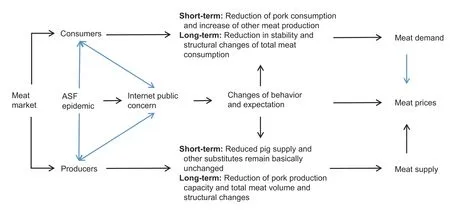
Fig.1 Theoretical mechanism of African swine fever (ASF) and its internet public concern on meat prices.

Fig.2 Cobweb changes of pork prices under influence of African swine fever.
From the perspective of the theory of consumer behavior,the change in the price of one commodity will inevitably lead to the change in the purchase amount among similar commodities,namely the substitution effects,which exists among pork,chicken,beef and mutton. On one side,because of ASF,consumers would like to reduce pork consumption and consequently buy larger quantities for other meats,which would result in higher prices of other meats due to stronger demand.On the other side,as the influence of ASF gradually fades,public confidence would come back and pork demand would gradually increase. Farmers would resume production to meet the rebound in demand,and both sides of supply and demand would reach a new equilibrium price P4under the new situation. At the same time,poultry and other meat prices would also restore to a new equilibrium along with the development of ASF.
2.2.Econometric methods
The standard VAR model with constant parameters allows drawing impulse responses only for a set of two variables under the assumption that parameters do not change over the horizon of the impulse responses. However,it is too strict for this assumption because of time-varying state in variables. Based on VAR model,the parameters in TVPVAR are estimated using a multivariate specification of the standard Kalman (Harvey 1991). In this article,the impact of ASF on meat prices in China is investigated with the estimation of TVP-VAR model developed by Primiceri (2005). According Nakajima (2011),the TVP-VAR model is constructed form the basic structural VAR model. This model includes both time-varying coefficients and timevarying variance-covariance matrices of the additive innovation (Toparlıet al.2019). Compared with the traditional VAR model,TVP-VAR allows for coefficients in an otherwise linear VAR model to vary over time following a specified law of motion,and allows for time variation in the variances of the error processes that affect the VAR (Lubik and Matthes 2015). TVP-VAR is characterized by exhibiting the time-varying characteristics of these parameters through calculating the interval and point impulse (response) function,which can reflect all the points in each variable impulse (response) of different lags. So this model is used to study the time-varying changes of the impulse effects of an independent variable from an external shock. In addition,the TVP-VAR model provides a flexible tool to account for the possible changes in the impact of ASF by letting data to determine whether the time variation of the linear structure derives from changes in the size of the shocks (impulse) or from changes in the propagation mechanism (response) (Primiceri 2005).
We consider a basic structural TVP-VAR model defined as the following:

whereytis an (n×1) vector of observed dependent variables andXtis the (n×k) matrix including intercepts and lags of the endogenous variables. For example,whenytrepresents the pork price and other variables are put inXtin one equation,we can use this model to measure the effect of variable ASF based on the different equations in this paper.βt,Atand ∑tare all time-varying. For simplicity,a number of assumptions are made for the specification of the TVP-VAR model.2For a discussion of these assumptions,please see Christiano et al.(1999).MatrixAtis assumed to be a lower-triangular matrix and the parameters are supposed to follow a random walk process as follows:
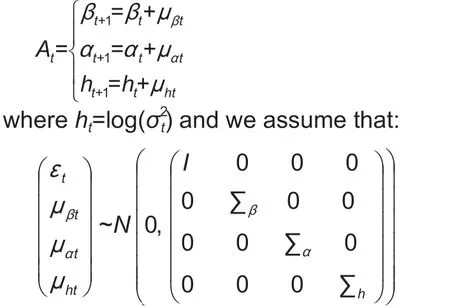
whereIis an identity matrix,∑β,∑αand ∑hare all positive definite matrices. At the same time,,it is assumed that the contemporaneous correlation coefficients between variables are not correlated. Bayesian method is used in the model estimation,and the posterior numerical estimation of the parameters is done using the Markov chain Monte Carlo (MCMC) method.
3.Data
3.1.Determination of ASF variable
In terms of the measurement of epidemic data,most authors take the occurrence as a dummy variable (Yuet al.2009;Zhou and Liu 2016),and others take the outbreak duration (Chen and Huang 2019) and the outbreak scope and severity (Miao 2019) as a quantitative index. But these measures cannot well reflect the severity of the influences of fatal diseases (Zheng and Ma 2018). Hence scholars are increasingly paying close attention to the opinions of internet users and big data in order to create alternative indexes that measure the impact of these diseases more accurately (Hassounehet al.2012;Fletcher 2014;Oppenheimet al.2019;Zenget al.2019) .
Currently,Google search data and Baidu Index are the two popular methods used as the proxy variable to predict the trends in some disease outbreaks such as influenza (Ginsberget al.2009). Baidu (www.baidu.com) is the largest Chinese search engine and the Google equivalent in China. Based on the massive daily web-searching data and Baidu news,Baidu Index has been launched since 2006,and many different keywords that the internet users care about and search on Baidu are included. The Baidu Index can be used to reflect the public online opinion about different keywords or topics during the past period,from which one can find,share,and mine information to reflect social hot spots,users’ interests and needs (Huanget al.2017).
In this study,based on Baidu Index,the internet public concern index of ASF was created to measure the variation and severity of the ASF epidemic. Firstly,several keywords closely related to the ASF event were selected through subjective selection combined with recommendations by Baidu search engine and map (Xu and Gao 2017;Zheng and Ma 2018). As a result,three aspects about ASF were considered in the following keyword determination and 7 keywords about ASF were selected. 1) Three keywords were used such as“swine fever”,“African swine fever”and“epidemic of ASF”,which could reflect the different names of ASF. 2) Two keywords were used such as“prevention and control of ASF”and“symptom of ASF”,which represents possible symptoms of ASF. The above keywords were used to reflect the ASF itself. 3) The third aspect covered two keywords including“can ASF infect to people”and“new trends of ASF”,which indicated people’s attitude and concern. Secondly,since the internet public concern changes rapidly and in order to obtain more data samples,weekly data were used. In addition,we took natural logarithm of the ASF index in order to eliminate heteroscedasticity,using the following formula:

whereASFindexis the internet public concern index ofASFandXi(i=1,2,...,7) is the searched data of theikeyword.The study period is from August 2018 to December 2019,and the trend ofASFindexis shown in Fig.3.
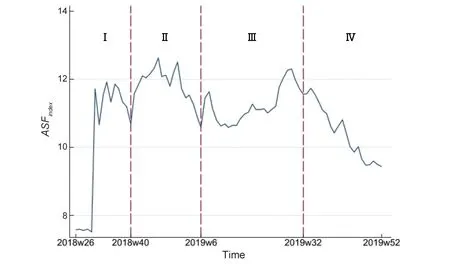
Fig.3 Index of African swine fever (ASF). I,II,III and IV,represent four stages including African swine fever (ASF) outbreak,diffusion,rebound and decline periods,respectively. W,week.
According to the characteristic of the internet public concern index,there are four stages including ASF outbreak,diffusion,rebound and decline periods,which are represented as I,II,III and IV,respectively in Fig.3.The first period is the initial outbreak stage of ASF,which covers from first week of August 2018 to first week of October 2018. During this period,ASF had its first outbreak in Shenyang and spread into other Northeast provinces including Liaoning,Jilin and Heilongjiang,which caused farmers to panic in these major pig production areas and attracted wide society concerns. While we can see in Fig.3 thatASFindexincreases suddenly and reaches to nearly 12 in less than a few weeks after the outbreak.ASFindexhad a brief fall at the end of stage I because the local government promptly took control of the infected farms. But then in the next few weeks,ASFindexclimbed up and reached the peak point of 12.36 in the 47th week in 2018,which was caused by the common concern of consumers and producers all over the country. With the implementation of measures to prevent ASF from further spreading,the index was slowly down to 10.59 in the 13th week in 2019. In stage II,ASF continuously occurred in the main pig production provinces,such as Sichuan,Chongqing,and Hunan and so on. Under the efforts of the central and local governments,ASF was under control and the index kept at a relatively lower level in III period. But the index rose up again later in stage III and reached above 12 again. The main causes of this trend was the occurrence of ASF in some west and coastal provinces/autonomous regions,such as Qinghai,Gansu and Guangxi. In the end the index exhibited a declining trend in the final stage,during which the confidence of the producers and consumers came back gradually andASFindexdecreased to 9.48 in the 51st week in 2019. This is likely due to effective measures and policies to control the fatal disease especially the progress in the study of ASF virus structure and vaccine by Chinese researchers.
3.2.Meat prices data
To investigate the influence of ASF on meat prices,four kinds of meat were used including pork,chicken,beef and mutton. The weekly prices from August 2018 to December 2019 were obtained from China Animal Husbandry Information Website. Pork and chicken prices were lower than that of beef and mutton in the investigation period,shown in Fig.4. There was a relatively moderate rising trend for pork price after the outbreak of ASF,and it increased rapidly from August 2019 and reached the highest price of 55.6 CNY kg-1in the 44th week in 2019. At the same time,chicken price kept a stable trend with a small increasing rate and also reached the highest price in the same week as pork price did. Beef and mutton prices had similar movement in the investigation period. Pork,chicken,beef and mutton prices in the 51st week in 2019 were 51.0,25.3,82.2,and 80.0 CNY kg-1,respectively,which were higher by 140.4,35.3,28.0 and 31.6% than the price levels in initial week of ASF in China. The statistical description results of the four kinds of meat prices in different periods according to the trend ofASFindexwere shown in Table 1.
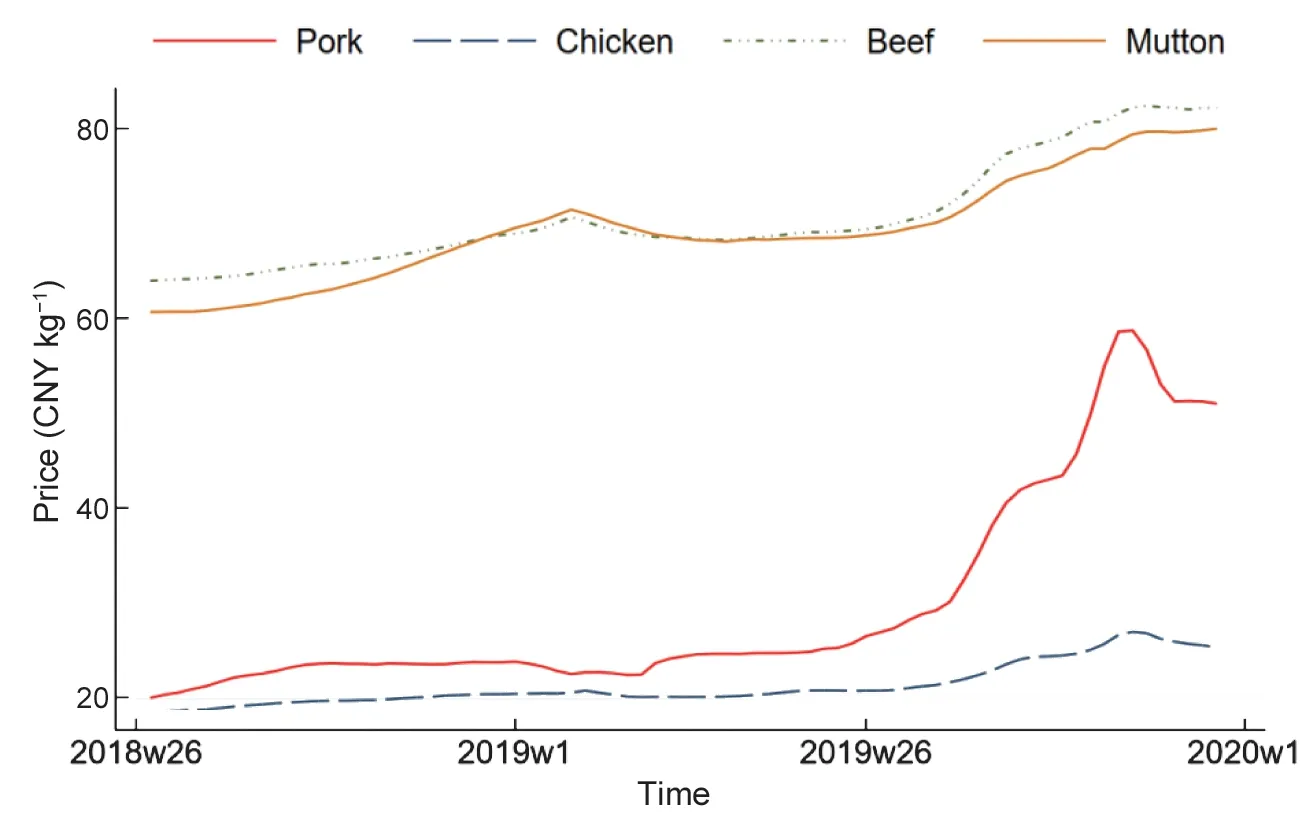
Fig.4 Meat prices after the outbreak of African swine fever (ASF). W,week.
4.Results and discussion
4.1.Model estimation
All price data were deflated by Consumer Prices Index and were taken natural logarithm before being modeled.Pork,chicken,beef and mutton prices,are indicated by lnPp,lnPc,lnPband lnPm,respectively.
Unit root testIntegration properties of the variables were investigated before TVP-VAR model estimation. The linear unit root tests are presented in Table 2 including ADF (Dickey and Fuller 1981),PP (Phillips and Perron 1988) and KPSS (Kwiatkowskiet al.1992). The lag length for the ADF test is chosen based on the Akaik information criterion (AIC). The PP and KPSS tests are estimated on the basis of the Parzen-Kernel,using the Newey-West and Andrews bandwidths respectively. The null hypothesis of the ADF and PP is that the series are nonstationary,while the null hypothesis is stationary against the alternative of a unit root for the KPSS test.The results imply that the first differences of all variables are stationary at level and can be treated as I(1) to be used in the following step of TVP-VAR and to ensure the validity of the model estimation results.
Markov Chain Monte Carlo SimulationThe parameters including the means,standard deviations,upper and lower 95% confidence intervals,convergence statistics of the posterior distribution and the inefficiency factors,are shown in Table 3. The mean values of posterior parameters all lie in the 95% confidence interval,and the diagnostic probability of Geweke is greater than 10%,which indicates that the hypothesis that the posterior distribution converges to zero cannot be rejected. As for the inefficiency,these factors except for (Σh)2are at a reasonable level,which shows that the estimated parameters are relatively robust.
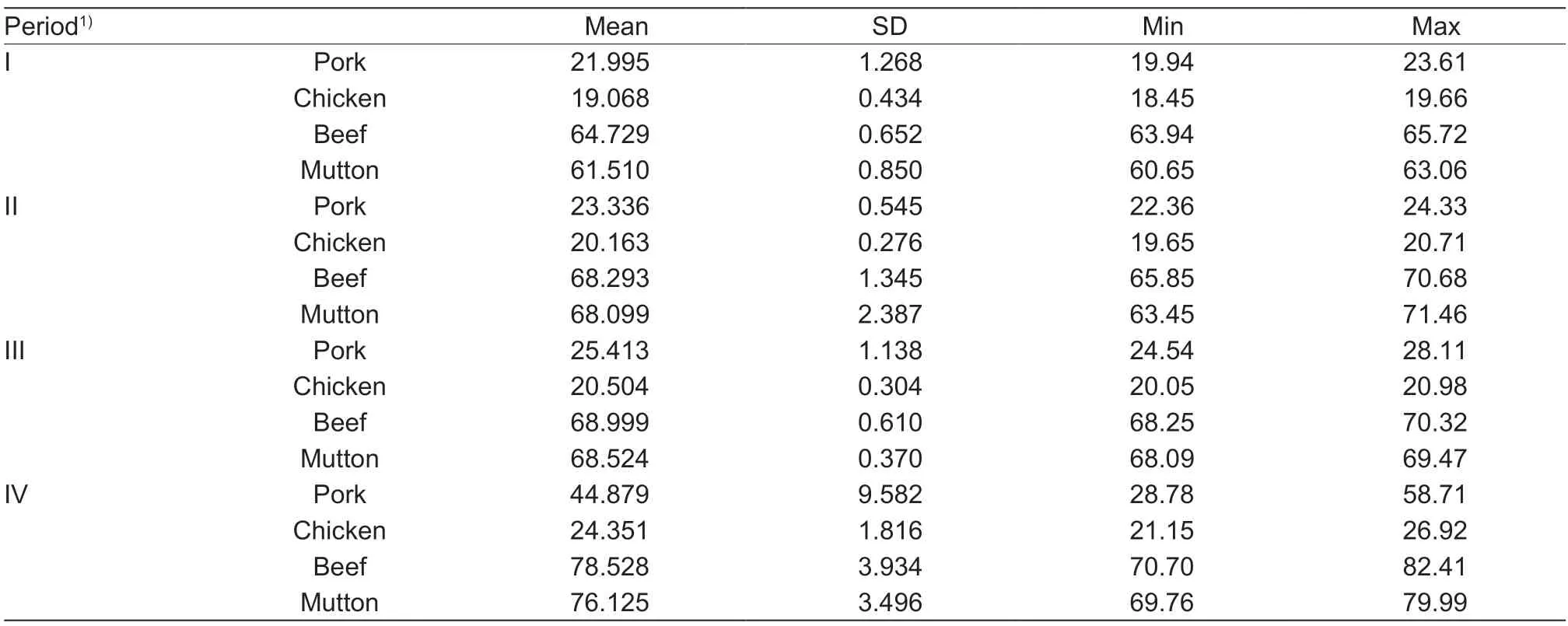
Table 1 Statistical description results of meat prices in four different periods

Table 2 Unit root test results

Table 3 Estimation results of TVP-VAR model
4.2.Time-varying impulse and response
Through two kinds of impulse response functions (IRF),such as equidistant and time-point IRF,TVP-VAR can effectively curve the dynamic time-varying relationship and characteristics between different variables. The former function can be used to investigate changes in the dependent variable after equal time intervals,caused by an independent variable under the external impulse at each time-point. The latter function can be used to investigate the attenuation of dependent variable over time,which is caused by an external impulse on independent variable at a specified time point.
Equidistant impulse responseThe time intervals of impulse response are set at three levels according to the principle of equidistant,such as 2 period ahead,4 periods ahead and 6 periods ahead. The IRF of ASF on meat prices are shown in Fig.5. The impacts can be investigated from three aspects such as impulse size,impulse time-effect and impulse direction. In terms of impulse size,the impacts of ASF on different meat prices are different. Specifically,ASF has the greatest impact on pork price,with the maximum positive impulse response ofASFindexon pork price being more than 0.015 units and the maximum negative impulse response being more than 0.03 units. But the impulse response on chicken price is between -0.009 and 0.0075 units,and the impacts on beef and mutton prices are relatively small. One possible reason for this result may be that ASF has a direct impact on pork price because pigs are the carrier of ASF,which directly affects the supply and demand for pork meat. As the most important substitute of pork,chicken price has a similar impact,while the impacts on beef and mutton prices are relatively small perhaps because their prices are much higher than that of pork and beef or mutton is not the main meat for many provinces in China.
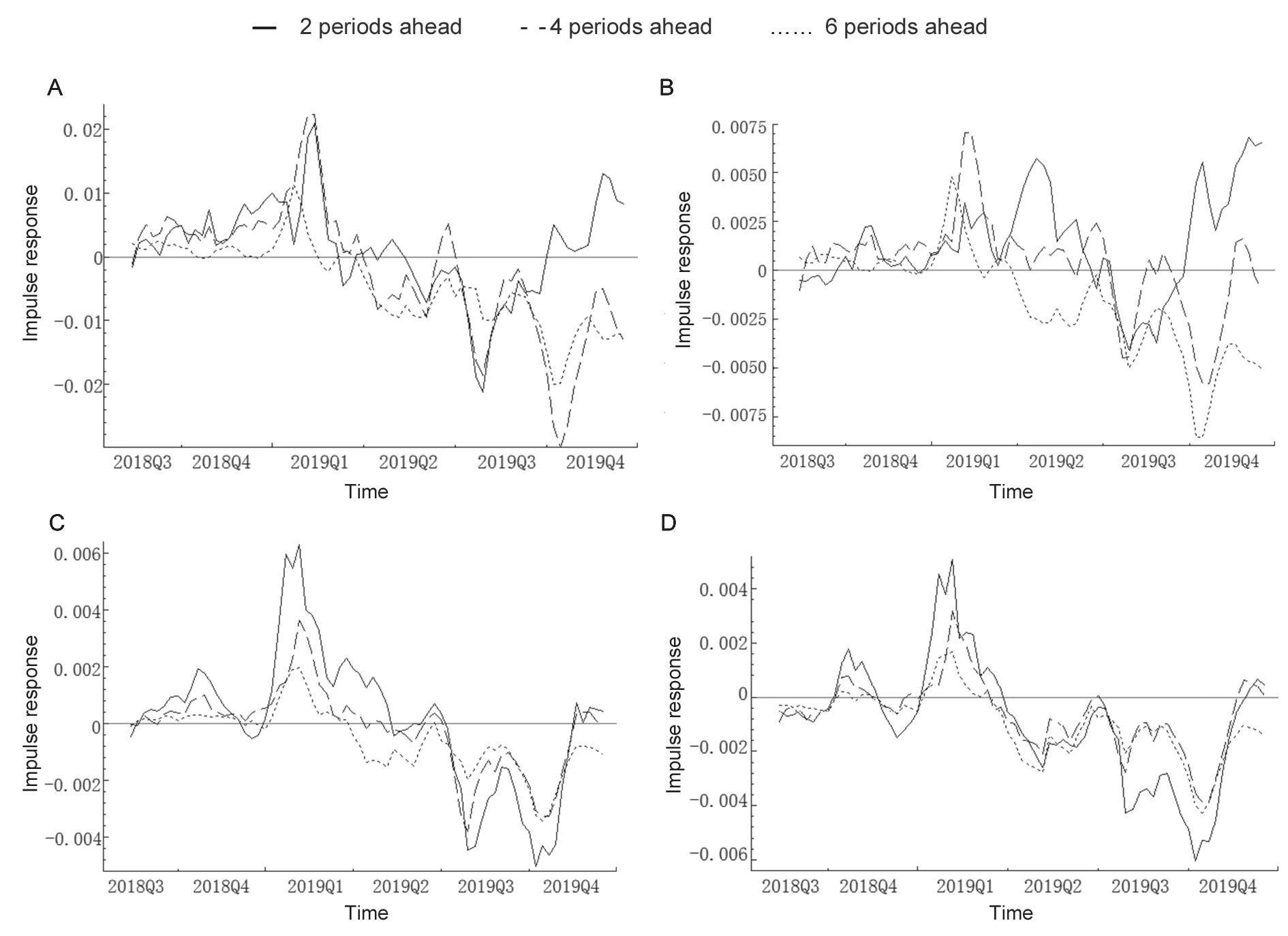
Fig.5 Equidistant impulse responses of ASFindex to different meat prices. A,pork. B,chicken. C,beef. D,mutton. Q,quarter.
Regarding the impulse effect,the impulse response on pork price has a relative higher magnitude regardless the number of periods ahead. However the impulse response on other meat prices is much stronger at 2 periods ahead than that at 4 periods or 6 periods ahead,which suggests that the impulse response on pork price is more sustainable and the impacts on other meat prices are short-term. At the same time,the impulse response directions are different at different period amongst different meat prices. For example,the impulse of ASF on pork price is mainly positive before the first quarter of 2019 and there is a synchronous rising relationship between ASF and pork price,namely,the higher ASF is,the more expensive pork price is. However,people’s attention on ASF has been falling in the second half in 2019,and pork price rose rapidly largely because of the shortage in supply,resulting in the impulse response ofASFindexon pork price being mainly negative. While the impulse response of other meat prices generally have the same trend as that of pork price,only chicken price increased during the last quarter of 2019 along with a higher pork price.
Time-point impulse responseAccording to the previous division of ASF,four time-points were selected,namely the 36th and 50th weeks in 2018,the 20th and 44th weeks in 2019,to investigate the time-point impulse response of ASF on four meat prices. The results are shown in Fig.6.
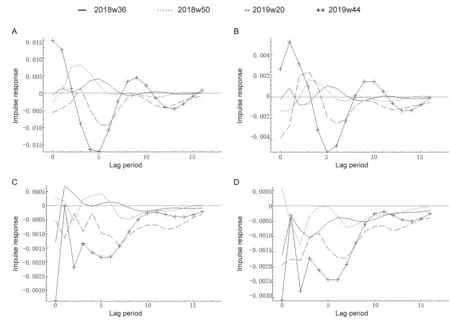
Fig.6 Time-point impulse responses of ASFindex to different meat prices. A,pork. B,chicken. C,beef. D,mutton. W,week.
The impulse strength is relatively small during the outbreak (I) and is relative larger in diffusion (II) periods,which indicates that the market response to ASF is relatively lagging behind. During the rebound period (III),the impacts strength of ASF on meat prices are obviously increasing,but there are differences amongst the four kinds of meats. The impulse impact is negative overall for pork price. The impacts on other meat prices are significantly smaller than that on pork price,although the impacts are slightly larger than that in the earlier stages.This is probably because the consumers changes their consumption behavior from pork to chicken because of ASF spread and chicken supplies can increase quickly during the past half year,likely because the impact of ASF mainly affects the demand side in this period. In addition,ASF does not directly affect the chicken,beef and mutton markets. It is worth noting that the impacts of ASF on all four meat prices are significantly larger during the fourth period (IV) than other three periods,although they have the same trends of converging to zero in the long run. As mentioned previously,the four meat prices increased by more than 30% than before the outbreak of ASF because of supply shortage with the development of ASF. For example,the national pork production in the period of the first eleven months in 2019 decreased by 17.2% compared with that in 2018,and the pig stock hit the bottom level in recent decades at the end of 2019. The ASF caused dramatic fluctuations of meat prices through affecting the supply side of livestock markets.
To summarize,the impact of ASF on the prices of different meat products shows obvious time-varying characteristics on the whole,and the impulse direction and size vary withASFindex,which is in line with the previous studies such as Shiet al.(2020) and Duan and Liu (2020). The similar results may be due to the change of the relationship between supply and demand in meat market along with the development of ASF. On the other hand,the dynamic IRFs ofASFindexon different meat prices exist obvious differences in the same period. It is notable that there are positive or negative IRFs during the sample period,which is accordance with studies of Tan and Wang (2021) and Zhuet al.(2019). But some researchers point out that ASF has a great positive impact on the price of livestock products and promotes the prices to rise in an all-round way (Shiet al.2020). However,the degree and progression of ASF were different in different provinces in China,there would be regional difference of the meat prices’ time-varying characteristics,which is one further direction in our following studies.
4.3.Robustness test
The results’ robustness was checked by additional analysis. Firstly,we estimated the linear version of the VAR model and checked the stability based on the plots of recursive residuals before proceeding to the TVPVAR estimation. The results are shown in Fig.7,which suggests the presence of serious parameter instabilities in the linear VAR model and supports the presence of nonlinearity in the residual generating mechanism and favors the use of a time-varying model.
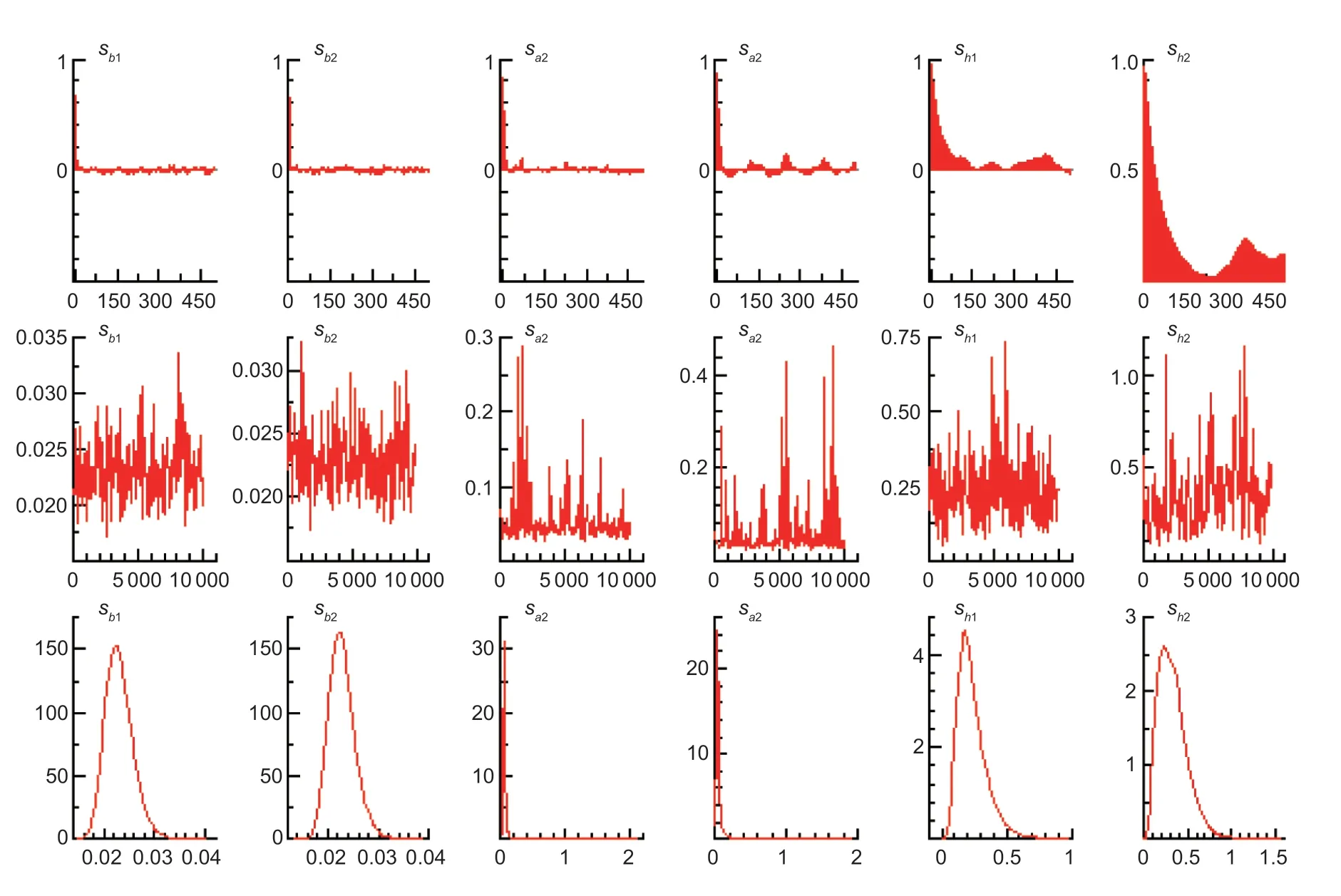
Fig.7 Sample autocorrelation functions,sample paths and posterior densities for selected parameters.
Secondly,Bayes vector auto-regression (BVAR) model was utilized to analyze the impact of ASF on meat prices and the impulse response results were shown in Fig.8.Nevertheless,BVAR models are proven to be a reliable tool for data description and forecasting,even though it can be used in analysis of stationary series with restrictive stationarity assumptions (Bekiros 2014). All the impulse responses ofASFindexon meat prices were positive and converged to zero. At the same time,for pork price the impulse response was much larger than that for other meat prices. All the results were generally similar with the results of the TVP-VAR model,although the BVAR model could not show the time-varying impulse response because of its linear characteristic.
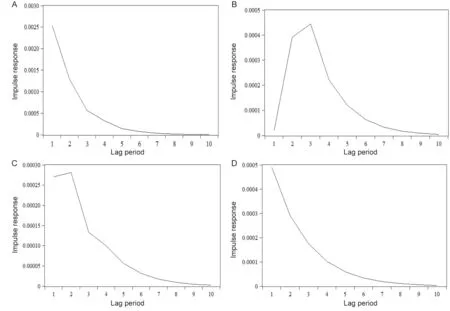
Fig.8 Impulse responses of ASFindex to different meat prices using Bayes vector auto-regression (BVAR). A,pork. B,chicken. C,beef. D,mutton.
Thirdly,we selected one component of theASFindex,the internet public concern of the keyword“African swine fever”,as the variable to estimate the impact on meat prices using TVP-VAR (Fig.9). The impulse response results were consistent with the previous estimated results,suggesting robustness of the empirical results.
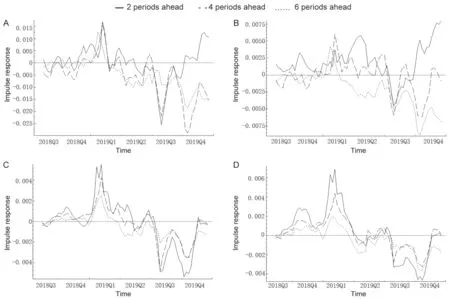
Fig.9 Impulse responses of internet public concern of African swine fever (ASF) to different meat prices using time-varying parameter vector auto-regressive (TVP-VAR). A,pork. B,chicken. C,beef. D,mutton. Q,quarter.
5.Conclusion and policy recommendations
This paper created an ASF public concern index and used it as the proxy variable for ASF. Using TVP-VAR model,this paper examined the impact of ASF on meat prices including pork,chicken,beef and mutton,and their dynamic relationships had been investigated after more than one-year of ASF outbreak for the period from August 2018 to December 2019. The results in general suggested that the impact of ASF on meat prices differ markedly over the investigation period. From the equidistant impulse response results,it can be seen that there were significant differences between the impacts of ASF on different meat prices,such as the impulse response size,direction and duration,which had obvious time-varying and heterogeneous characteristics. As for the impulse response size,the impact on pork price was larger than that on chicken price,but the impacts on beef and mutton prices were relatively small. At the same time,the impulse response on pork price lasted a longer period while the impulse responses on others were short-term. The results of time-point impulse response showed that there were differences between the impacts of ASF on meat prices and the degree and trend of ASF. There was a strong relationship between the impulse intensity and the degree and lasting-time of ASF. Generally speaking,it was weak in the early period of ASF,but became apparent and stronger in the middle and later periods. However,the impact was still strong although ASF had been in control.
As an acute,highly lethal and infectious disease,ASF has an obvious and direct impact on the pig industry,which is directly reflected in the fluctuation of pork prices and affects the supply and demand of other meats. The results of this paper indicate that policy makers can enhance macro regulations to smooth the livestock meat prices. Given that ASF has an overall impact on the four kinds of meat prices,the government should make strict breeding standard to prevent ASF and other animal diseases spread firstly. In view of the varying impacts of ASF on different meat prices,the early warning and monitoring system should be strengthened in livestock market based on big data technologies,which should be put more attention on the main meat price such as pork price. At the same time,taking into account the impacts of ASF on both supply and demand,it is important for the central and local governments to standardize pork production and circulation and to provide guidance and information regarding ASF in order to ensure smooth and steady development of livestock industry in future.
Acknowledgements
This study was supported by the National Natural Science Foundation of China (72073131),the Central Public-Interest Scientific Institution Basal Research Fund,China (2020JKY025) and the Agricultural Science and Technology Innovation Program of Chinese Academy of Agricultural Sciences (CAAS-ASTIP-2016-AII).
Declaration of competing interest
The authors declare that they have no conflict of interest.
杂志排行
Journal of Integrative Agriculture的其它文章
- Adoption of small-scale irrigation technologies and its impact on land productivity:Evidence from Rwanda
- The impacts of oxytetracycline on humification during manure composting can be alleviated by adjusting initial moisture contents as illustrated by NMR
- Effects of long-term straw incorporation on nematode community composition and metabolic footprint in a rice-wheat cropping system
- Functional diversity of soil microbial communities in response to supplementing 50% of the mineral N fertilizer with organic fertilizer in an oat field
- Nitrogen acquisition,fixation and transfer in maize/alfalfa intercrops are increased through root contact and morphological responses to interspecies competition
- Kaempferol inhibits Pseudorabies virus replication in vitro through regulation of MAPKs and NF-κB signaling pathways
